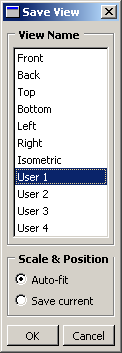Saving a user-defined view | ||||||||
|
| |||||||
Context:
Use the save tool
 in the
Views toolbar
to open the Save Views dialog box and save a user-defined
view. The Save Views dialog box is illustrated in the
following figure:
in the
Views toolbar
to open the Save Views dialog box and save a user-defined
view. The Save Views dialog box is illustrated in the
following figure:

Use the Scale & Position options to
determine whether the saved view contains zoom factor and position information.